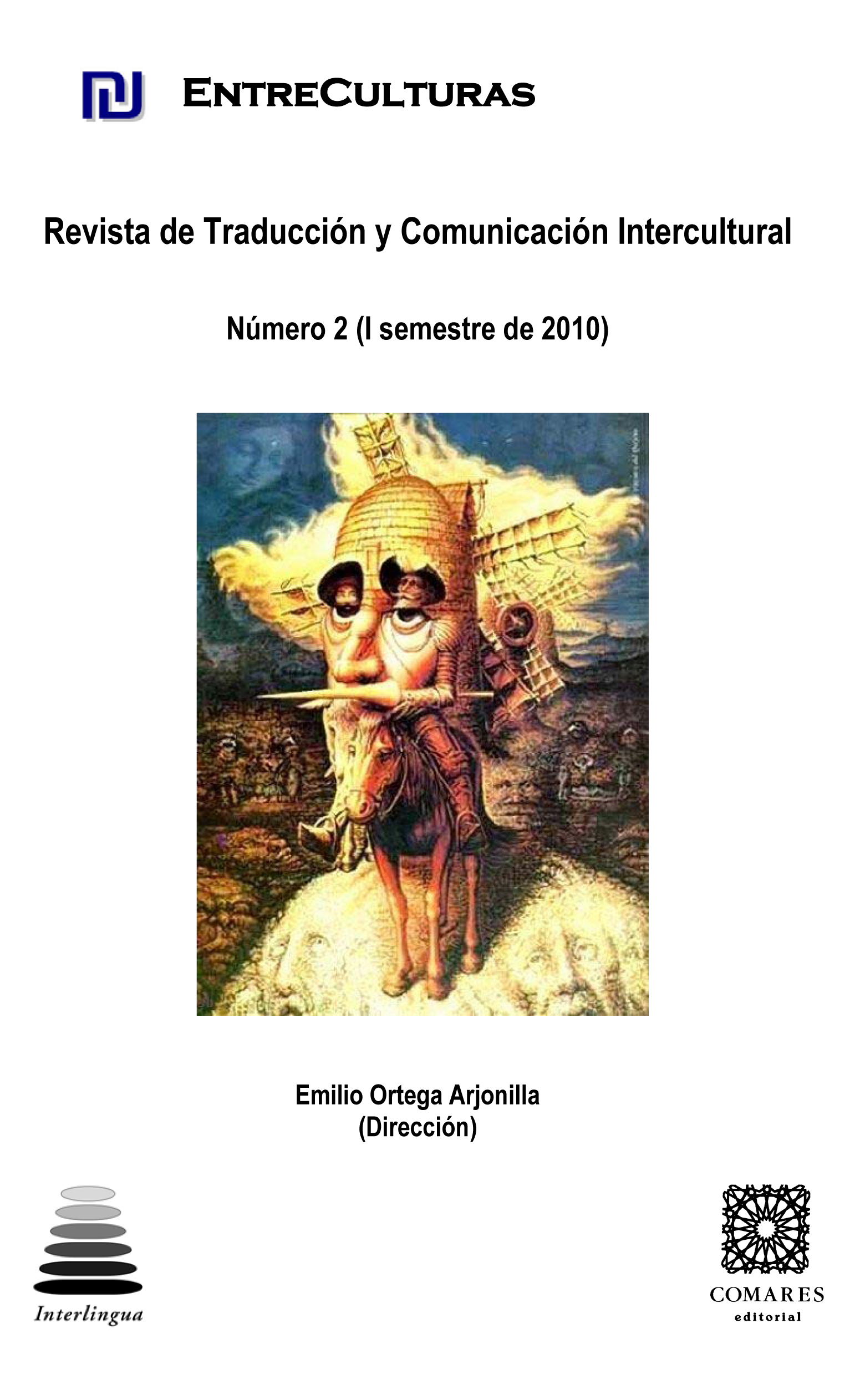APPROACHING THE AUDIO DESCRIPTION OF HUMOUR
DOI:
https://doi.org/10.24310/Entreculturasertci.vi2.11762Keywords:
media accessibility, audio description, humour, audiovisual translationAbstract
The main purpose of this article is to provide an introduction to audio description (AD) and to approach the question of the AD of humour. AD is defined, the current situation of this practice is briefly discussed, and some of the most significant works on AD are mentioned. A case study is then presented, the main objective of which was to analyse (from a descriptive perspective and focusing on visual jokes) the AD of the British comedy film I want Candy (several examples are given to illustrate the way humour was dealt with by the AD agent). Among others, some of the main findings discussed are that 1), although some marginal and punctual instances of description over dialogue were found, the general rule of using the gaps or silences between dialogues to insert the descriptions was observed (this sometimes meant losing potentially humorous elements) and 2) almost two fifths of the visual humorous fragments were not described, most likely due to time restrictions. Finally, some further research is suggested.
Downloads
Metrics
References
AGOST, R. (1999): Traducción y doblaje: Palabras, voces e imágenes. Barcelona, Ariel.
BENECKE, B. (2004): “Audio Description,” Meta, 49(1), 78-80.
BOURNE, J. Y JIMÉNEZ-HURTADO, C. (2007): “From the visual to the verbal in two languages: a contrastive analysis of the audio description of The Hours in English and Spanish” en Díaz-Cintas J. et al. (eds.): Media for All: Subtitling for the Deaf, Audio Description and Sign Language. Ámsterdam, Rodopi, 175-187.
BRAUN, S. (2007): “Audio Description from a discourse perspective: a socially relevant framework for research and training,” http://epubs. surrey.ac.uk/translation/1 [30 March 2009].
CHAUME, F. (2004): Cine y traducción. Madrid, Cátedra.
CHAVES, M. J. (2000): La traducción cinematográfica. El doblaje. Huelva, University of Huelva.
CHIARO, D. (2000): “Servizio completo? On the (Un)translatability of Puns on Screen” en Bollettieri Bosinelli R. M. et al. (eds.): La traduzione multimediale. Quale traduzione per quale testo? Bologna, CLUEB, 27-42.
? (2003): “The Implications of the Quality of Translated Verbally Expressed Humour and the success of big screen comedy,” Antares, VI, 14-20.
? (2006): “Verbally Expressed Humour on Screen: Reflections on Translation and Reception,” JoSTrans, 6, 198-208.
DÍAZ-CINTAS, J. (2008): “Introduction” en Díaz-Cintas J. (ed.): The Didactics of Audiovisual Translation. Ámsterdam / Philadelphia, John Benjamins, 1-18.
? (ed.) (2008): The Didactics of Audiovisual Translation. Ámsterdam / Philadelphia, John Benjamins.
?; ORERO, P. Y REMAEL, A. (eds.) (2007): Media for All: Subtitling for the Deaf, Audio Description and Sign Language. Ámsterdam, Rodopi.
FRAZIER, G. (1975): The Autobiography of Miss Jane Pitman: An All-audio Adaptation of the Teleplay for the Blind and Visually Handicapped. San Francisco State University.
FUENTES, A. (2001a): La recepción del humor audiovisual traducido: estudio comparativo de fragmentos de las versiones doblada y subtitulada al español de la película Duck Soup, de los hermanos Marx. University of Granada.
? (2001b): “Estudio empírico sobre la recepción del humor audiovisual” en Lorenzo L. y Pereira A. M. (eds.): Traducción subordinada (II): El subtitulado. Vigo, University of Vigo, 69-84.
MARTÍNEZ-SIERRA, J. J. (2004): Estudio descriptivo y discursivo de la traducción del humor en textos audiovisuales. El caso de Los Simpson. Jaume I University.
? (2008): Humor y traducción. Los Simpson cruzan la frontera. Castellón de la Plana, Jaume I University.
? (2009): “The Relevance of Humour in Audio Description,” Intralinea, 11.
MARTÍNEZ-TEJERINA, A. (2008): La traducción para el doblaje del humor basado en la polisemia. University of Alicante.
ORERO, P. (2005): “Audio Description: Professional Recognition, Practice and Standards in Spain”. Translation Watch Quarterly, 1, 7-18.
? (2007): “Sampling audio description in Europe” en Díaz-Cintas J. et al. (eds.): Media for All: Subtitling for the Deaf, Audio Description and Sign Language. Ámsterdam, Rodopi, 111-125.
? Y WHARTON, S. (2007): “The Audio Description of a Spanish Phenomenon: Torrente 3”. JoSTrans, 7, 164-178.
SNYDER, J. (2008): “Audio description. The visual made verbal” en Díaz-Cintas J. (ed.): The Didactics of Audiovisual Translation. Ámsterdam / Philadelphia, John Benjamins, 191-198.
TOURY, G. (1995): Descriptive Translation Studies and Beyond. Ámsterdam/Philadelphia, John Benjamins.
VERCAUTEREN, G. (2007): “Toward a European guideline for audio description” in Díaz-Cintas J. et al. (eds.): Media for All: Subtitling for the Deaf, Audio Description and Sign Language. Ámsterdam, Rodopi, 139-149.
ZABALBEASCOA, P. (1993): Developing Translation Studies to Better Account for Audiovisual Texts and Other New Forms of Text Production. University of Lleida.
? (1994, April): “The P-R Model of Translation.” Paper presented at the First International Conference on Linguistics, Literature and Translation, Yarmouk University (Irbid, Jordan).
? (1996): “Translating Jokes for Dubbed Television Situation Comedies” en Delabastita D. (ed.): The Translator: Studies in Intercultural Communication 2. Manchester, St. Jerome, 235-257.
Downloads
Published
How to Cite
Issue
Section
License
All contents published in Entre culturas. Revista de traducción y comunicación intercultural are protected under the Creative Commons Attribution-NonCommercial-ShareAlike 4.0 International (CC BY-NC-SA 4.0) license. All about this license is available in the following link: <http://creativecommons.org/licenses/by-nc-sa/4.0>
Users can copy, use, redistribute, share and exhibit publicly as long as:
- The original source and authorship of the material are cited (Journal, Publisher and URL of the work).
- It is not used for comercial purposes.
- The existence of the license and its especifications are mentioned.
There are two sets of authors’ rights: moral and property rights. Moral rights are perpetual prerogatives, unrenounceable, not-transferable, unalienable, imprescriptible and inembargable. According to authors’ rights legislation, Entreculturas. Revista de traducción y comunicación intercultural recognizes and respects authors moral rights, as well as the ownership of property rights, which will be transferred to University of Malaga in open access. The property rights are referred to the benefits that are gained by the use or the dissemination of works. Entreculturas. Revista de traducción y comunicación intercultural is published in an open access form and it is exclusively licenced by any means for doing or authorising distribution, dissemination, reproduction, , adaptation, translation or arrangement of works.
Authors are responsable for obtaining the necessary permission to use copyrighted images.





7.png)
